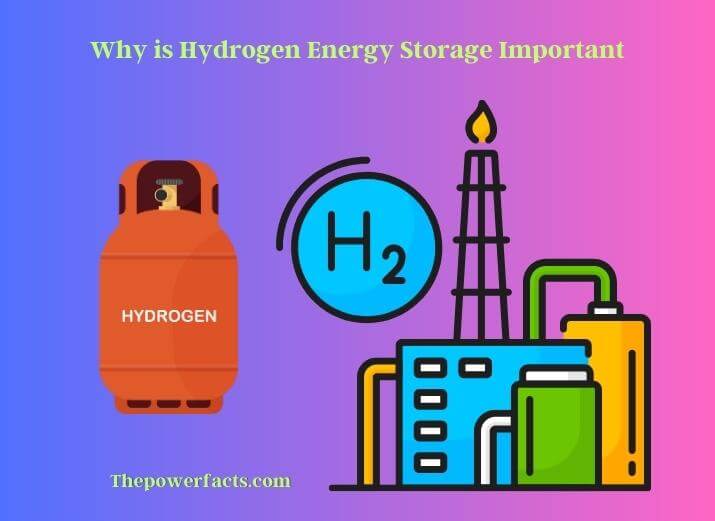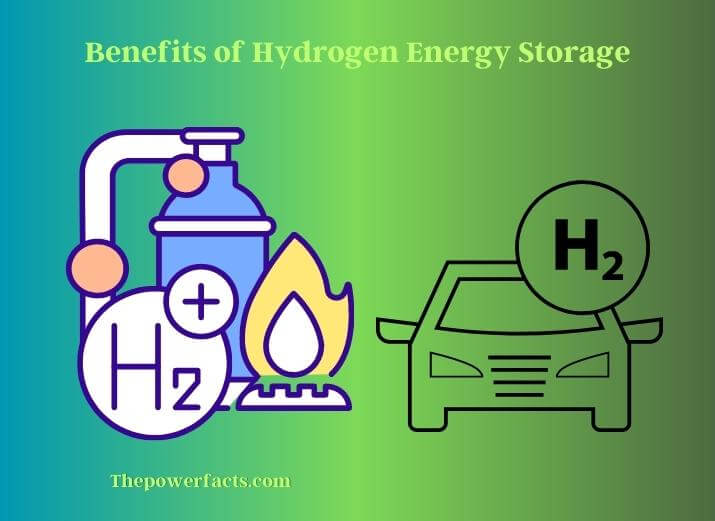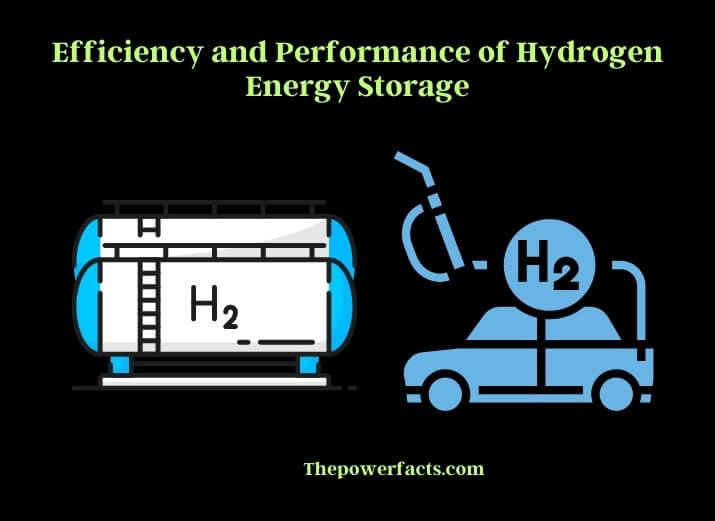Published on: March 21, 2023
Written by Jonas Frank / Fact-checked by Nova Scarlett
As the world transitions towards cleaner and more sustainable forms of energy, one of the key challenges is finding ways to store renewable energy sources efficiently and affordably. Renewable energy sources such as wind and solar are inherently intermittent and variable, meaning that energy production can fluctuate throughout the day and from day to day. To address this challenge, energy storage solutions are needed to store excess energy during times of high production and release it during times of low production.

Hydrogen energy storage is emerging as a promising solution to this challenge, offering a flexible, long-term storage solution that can be used to balance the intermittent supply of renewable energy sources. By converting excess renewable energy into hydrogen gas through a process called electrolysis, the hydrogen can then be stored and used to generate electricity when needed through a process called fuel cell technology. This process is emissions-free and produces only water as a byproduct, making it a clean and sustainable energy solution.
As with any emerging technology, there are costs associated with the production, storage, and infrastructure development of hydrogen energy storage. Understanding hydrogen energy storage regulations is essential for anyone involved in the energy industry. Balancing these costs with the potential benefits of this technology is crucial for determining whether it is a viable solution for meeting the world’s energy needs.
What is Hydrogen Energy Storage?
Hydrogen energy storage involves using hydrogen gas as a means of storing energy. The process involves converting surplus electricity from renewable sources, such as wind or solar power, into hydrogen gas through a process called electrolysis. The hydrogen gas can then be stored in tanks and used to generate electricity when needed, either through combustion or fuel cells.
Why is Hydrogen Energy Storage Important?
One of the biggest challenges facing the transition to a clean energy future is the intermittent nature of renewable energy sources. Wind and solar power are subject to fluctuations in availability, making it difficult to rely on them as a constant source of energy. Hydrogen energy storage can help to address this issue by providing a means of storing excess energy during times of plenty, and releasing it when needed.

Types of Hydrogen Energy Storage
Hydrogen energy storage can be achieved through several different methods, each with its own advantages and disadvantages. The most common methods of hydrogen energy storage include compressed hydrogen gas, liquid hydrogen, and solid-state hydrogen storage.
Compressed Hydrogen Gas Storage
Compressed hydrogen gas storage involves storing hydrogen gas in high-pressure tanks. The tanks must be designed to withstand high pressures, typically ranging from 350 to 700 bar, in order to store enough hydrogen to be useful. Compressed hydrogen gas storage is a mature technology and is currently the most commonly used method of hydrogen energy storage. It does have limitations, including the high cost of the tanks and the relatively low energy density of compressed hydrogen gas.
Liquid Hydrogen Storage
Liquid hydrogen storage involves storing hydrogen in a liquid state, which requires cooling the hydrogen gas to extremely low temperatures. Liquid hydrogen has a much higher energy density than compressed hydrogen gas, allowing for more hydrogen to be stored in a smaller space. Liquid hydrogen storage is more complex and expensive than compressed hydrogen gas storage, as it requires cryogenic cooling systems to maintain low temperatures.

Solid-State Hydrogen Storage
Solid-state hydrogen storage involves storing hydrogen in a solid form, typically as a metal hydride or a carbon nanotube. Solid-state hydrogen storage has the potential to offer high energy density, as well as improved safety and ease of transport. It is still an emerging technology and currently has limited commercial availability.
Note
Each method of hydrogen energy storage has its own unique advantages and challenges. The choice of which method to use will depend on the specific application and the available infrastructure. Regardless of the method used, hydrogen energy storage offers a promising solution to the challenge of storing renewable energy sources efficiently and affordably, paving the way toward a clean energy future.
Benefits of Hydrogen Energy Storage
Flexibility
Hydrogen energy storage is highly flexible, allowing for the storage of excess energy in a variety of forms. Hydrogen can be used to power vehicles, provide electricity to homes and businesses, and even feed back into the grid.
Long-Term Storage
Hydrogen energy storage has the potential to provide long-term storage of energy, which is essential for balancing the intermittent nature of renewable energy sources. The ability to store energy over extended periods of time allows for a constant supply of energy to be maintained, even when renewable sources are not available.

Clean Energy
Hydrogen is a clean energy source, with no harmful emissions produced during its use. This makes it an ideal option for powering vehicles and homes, and for feeding back into the grid to meet demand.
Costs of Hydrogen Energy Storage
Production Costs
One of the biggest costs associated with hydrogen energy storage is the production of hydrogen gas. The process of electrolysis, which is used to produce hydrogen gas, is energy-intensive and expensive.
Storage Costs
Storing hydrogen gas is also a costly process. Hydrogen must be stored under high pressure or at extremely low temperatures, both of which require specialized equipment.
Infrastructure Costs
In order for hydrogen energy storage to become a viable solution, significant infrastructure will need to be developed. This includes the development of new pipelines, storage facilities, and transportation systems.
Efficiency and Performance of Hydrogen Energy Storage
The efficiency and performance of hydrogen energy storage systems are critical factors in determining the viability of this technology as a clean energy solution. The efficiency of a hydrogen energy storage system refers to the amount of energy that is lost during the storage and retrieval process, while performance refers to the ability of the system to store and release energy as needed.

The efficiency of hydrogen energy storage systems can vary depending on the method used for storage and retrieval. For compressed hydrogen gas storage, the efficiency is typically around 70-75%, meaning that approximately 25-30% of the stored energy is lost during the process. Liquid hydrogen storage can be more efficient, with efficiencies of up to 85%, but it requires more energy to cool the hydrogen gas to extremely low temperatures. Solid-state hydrogen storage is still an emerging technology, and its efficiency and performance are still being studied.
In terms of performance, hydrogen energy storage systems offer several advantages over other energy storage solutions. For example, hydrogen energy storage can be scaled up or down easily to meet changing energy demands. Hydrogen energy storage systems can be located close to the energy source, reducing the need for long-distance transmission lines. This can also improve the stability of the energy grid by reducing the likelihood of power outages.
Another important factor in the performance of hydrogen energy storage systems is the ability to store and release energy quickly. Fuel cell technology allows for rapid energy conversion, making it well-suited for meeting sudden changes in energy demand. The cost of fuel cell technology remains relatively high, which can limit the widespread adoption of hydrogen energy storage systems.
Current Applications of Hydrogen Energy Storage
Hydrogen energy storage has a wide range of potential applications across various industries, including transportation, energy generation, and industrial processes. While the technology is still in its early stages, there are already several promising applications of hydrogen energy storage in use today.
Transportation
Hydrogen fuel cell vehicles are one of the most well-known applications of hydrogen energy storage in transportation. Fuel cell vehicles use hydrogen gas to generate electricity, which powers an electric motor to drive the vehicle. Fuel cell vehicles offer several advantages over traditional gasoline-powered vehicles, including zero emissions, longer range, and faster refueling times. The limited availability of hydrogen refueling stations remains a significant barrier to widespread adoption.
Energy Generation
Hydrogen energy storage can be used to store excess energy from renewable energy sources, such as wind and solar, for use during times of peak demand. This can help to stabilize the energy grid and reduce the need for fossil fuel-based power plants. Hydrogen energy storage can also be used in conjunction with fuel cells to generate electricity in remote locations where the grid connection is not available.
Industrial Processes
Hydrogen energy storage can be used in industrial processes, such as refining and chemical production, as a source of clean energy. For example, hydrogen can be used as a feedstock for the production of ammonia, which is used in fertilizers, or as a fuel for industrial boilers.
While these applications of hydrogen energy storage are still relatively limited, they offer a glimpse of the potential of this technology to transform the way we generate, store, and use energy. Continued research and development will be critical for improving the efficiency and affordability of hydrogen energy storage and expanding its range of applications.
Challenges and Limitations of Hydrogen Energy Storage
While hydrogen energy storage offers many potential benefits, there are also several challenges and limitations that must be addressed in order for this technology to become a widespread solution for clean energy.
Innovations and Advancements in Hydrogen Energy Storage
As the need for clean energy solutions continues to grow, researchers and engineers are working to develop new innovations and advancements in hydrogen energy storage.
Green Hydrogen Production
Traditional methods of producing hydrogen gas typically rely on fossil fuels, which can be expensive and environmentally damaging. Researchers are developing new methods for producing hydrogen gas using renewable energy sources, such as wind and solar power. This “green hydrogen” production could significantly reduce the environmental impact of hydrogen energy storage.
Advanced Storage Methods
While current methods of hydrogen energy storage have limitations, researchers are working to develop new storage methods that are more efficient and cost-effective. For example, researchers are exploring the use of metal hydrides and other advanced materials to store hydrogen gas in a more compact and energy-efficient manner.
Improved Fuel Cell Technology
Fuel cells are a critical component of many hydrogen energy storage systems, as they convert hydrogen gas into electricity. Researchers are working to develop more efficient and durable fuel cell technology, which could increase the overall efficiency and reliability of hydrogen energy storage systems.
Infrastructure Development
To support the widespread adoption of hydrogen energy storage, significant investments will be needed in infrastructure development. Researchers and policymakers are working to identify the most effective strategies for building a hydrogen energy storage infrastructure that can support a clean energy future.
These and other innovations and advancements in hydrogen energy storage hold the potential to transform the way we generate, store, and use energy. Continued research and development, along with public and private sector investments, will be critical for unlocking the full potential of this promising technology.
Economic and Environmental Impacts of Hydrogen Energy Storage
Here is a table summarizing the economic and environmental impacts of hydrogen energy storage:
| Economic Impacts | Environmental Impacts |
| Can reduce reliance on fossil fuels and decrease energy costs over time | Can significantly reduce greenhouse gas emissions, particularly if produced using renewable energy sources |
| Requires significant upfront investment in infrastructure and technology development | May require significant land use for hydrogen production and storage facilities |
| Has the potential to create new jobs in the clean energy sector | May have some negative impacts on local ecosystems and biodiversity |
| Current production and storage costs can be high, although costs are expected to decrease over time with increased investment and technological advancements | Some methods of hydrogen production and storage may require significant energy inputs, reducing overall efficiency and potentially increasing emissions |
Hydrogen Energy Storage in the Global Energy Transition
As the world seeks to transition to a cleaner, more sustainable energy future, hydrogen energy storage has emerged as a key player in the global energy mix. This technology has the potential to help address some of the most pressing challenges facing the energy sector, including reducing greenhouse gas emissions, enhancing energy security, and improving the reliability and resiliency of the grid.
Hydrogen can be produced using a variety of energy sources, including renewable sources like wind and solar power, and can be used in a range of applications, from powering vehicles to providing backup power for buildings and communities. This flexibility makes hydrogen energy storage well-suited for supporting a range of energy needs and use cases, from large-scale grid storage to smaller-scale applications like powering remote communities.
Hydrogen energy storage is the potential to help address the intermittency of renewable energy sources. Because wind and solar power can be variable depending on weather conditions and time of day, energy storage solutions are needed to ensure that clean energy is available when and where it is needed. Hydrogen energy storage can serve as a reliable and efficient means of storing excess renewable energy for later use, helping to balance the grid and increase the overall reliability and resiliency of the energy system.
There are also challenges to the widespread adoption of hydrogen energy storage. As discussed earlier, the technology currently requires significant upfront investment in infrastructure and technology development, and current production and storage costs can be high. Additionally, significant investments in infrastructure will be needed to support the widespread deployment of hydrogen energy storage systems, including building a network of production and storage facilities and developing distribution pipelines.
Many governments, companies, and research institutions are making significant investments in hydrogen energy storage, recognizing its potential to transform the energy sector and contribute to a cleaner, more sustainable energy future. For example, the European Union has set a target of producing 10 million tons of renewable hydrogen per year by 2030, while Japan has identified hydrogen energy storage as a key pillar of its energy transition strategy.
Final Thoughts
Hydrogen energy storage has emerged as a promising technology that holds significant potential for supporting the global transition to a cleaner, more sustainable energy future. With its versatility, efficiency, and potential to help address the intermittency of renewable energy sources, hydrogen energy storage can play an important role in addressing some of the most pressing challenges facing the energy sector today.
While there are certainly challenges and limitations to the widespread adoption of hydrogen energy storage, continued investment and innovation in this field could help overcome these challenges and unlock the full potential of this promising technology. As governments, companies, and research institutions around the world continue to invest in hydrogen energy storage, we can expect to see significant advancements and breakthroughs in the coming years.
As we look to the future of energy, hydrogen energy storage will undoubtedly play a key role in shaping the global energy mix. By balancing the costs and benefits of this technology, we can work toward a cleaner, more sustainable energy future that meets the needs of people and the planet alike.
